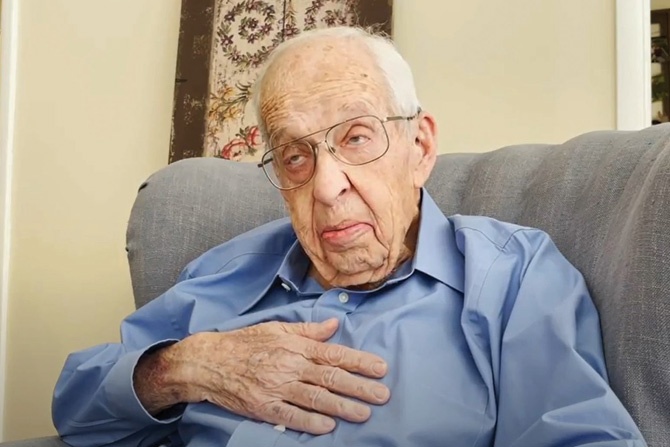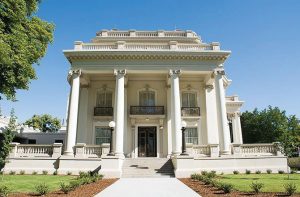The Utah Chapter of the American Institute of Architects has been meeting with some of the retired architectural legends in our community. We are archiving their personal memories of practicing architecture during the second half of the 20th Century, as well as capturing their personalities on film. Each architect we talked with had different career goals and trajectories, but there is a common theme of building practices before and during when technology took over. The design industry has evolved to become much more computer-driven, and the profession became much more sophisticated, corporate, and fiercely competitive.
We have video recorded these interviews and will be releasing much-shortened video versions to our members through e-blasts. The complete interviews will be archived for posterity, and of course, for the architects’ friends and families for their personal use.
Our first interview was with Elden Talbot. We met with him in May 2020 and talked about what attracted him to architecture and his practice, partners, struggles, successes, and guiding philosophies. Talbot was one of the second generation of architects that guided the architecture firm Ashton Evans and Brazier, founded in 1923, into a new iteration of the firm that they called Montmorency Hayes and Talbot (MHT, later MHTN).
Elden Talbot is now 89, retired for thirty years, and living with his son-in-law. The interviewers met with him one morning in May in their home in Emigration Canyon. He was bright, happy to tell his story, apologized that he is a little hard of hearing but very quick with clear answers and quite a few opinions.
When did you decide to be an architect?
In high school, I wanted to be a landscape architect, so I took Latin so I could know botanical names and so forth. But my dad was a building contractor, and I worked on summer jobs with him, and I finally decided that maybe I wanted to switch my thinking and become an architect.
Where did you go to school?
I lived in Idaho Falls at the time, but I went to the University of Utah. I started school at the U in 1950. Roger Baily was the Dean of the School of Architecture.
At the time, there were no lady students of architecture. Frank Lloyd Wright was coming to Salt Lake to be interviewed for a project at Westminster College, so they invited him to speak to the students; so since he was coming, we put up the very finest work we could come up with in our little exhibition hall [the school was in a barracks building] for him to look at. He was speaking to us, and all of a sudden, he stopped, in the middle of his talk, and he went around, and looked at all the exhibits and came back and said, ‘gentlemen, you are wasting your time.’ That made the professors very happy.
Salt Lake City Mayor Earl Glade took Frank Lloyd Wright on a trip around Salt Lake, and in the course of it, they went to Temple Square. He wanted to go in the Temple, and he told him he couldn’t go in there. He had a little hard time understanding that, but he went in the Tabernacle. He was just taken with that building, and when he left that building, he went up in the roof structure; when he left that building, he said, “This is one of the finest pieces of architecture in this country and perhaps the world.”
After you graduated, where did you go next?
I graduated in 1954. The Korean War was on. I went immediately into the army. I fully expected to get sent to Korea, and instead, they sent me to Ft Lewis, Washington. (After his stint) I did go into Seattle and talk to a few firms, and I had some offers, but my wife said, “I can’t take this rain.” I could get a higher architectural starting salary in Idaho Falls than in Salt Lake, but I always intended to come to Salt Lake. I worked in Idaho Falls for a few years, and then I came to Salt Lake.
When I came to Salt Lake, I had three offers – one of them was from Ashton, Evans and Brazier. Fred Montmorency and Dave Hayes were there, so I decided to go to work for them. Ray Ashton was retired, and Ray Evans was very ill with cancer. He had me take him around to the site observation visits; I got to know him quite well. Most of the people in the office were scared to death of him because he could be very abrasive. He expected to be respected. They didn’t call him Ray; they called him Mr. Evans. So, when he got worse, I kind of took over his jobs. I’d been working for him for a few months and he had a period of three weeks where he hadn’t been in the office. So, he came in, and he was going over the projects, and he said, “Oh, that’s not the way I wanted it done.” Stupid me, I said, “Mr. Evans, I learned a lot in architecture school, but I didn’t learn to read your mind.” You could have heard a pin drop. I thought I was done. That cemented him to me; it was just the kind of thing he liked. He did a lot for me, and I have the greatest respect for Ray Evans.
You were a second-generation firm?
We were second generation. I was there for about six years and became an associate, and when Bud Brasier passed away, we reorganized the firm and made it Montmorency Hayes and Talbot.
Is there a part of the practice you specialized in?
Because Ray Evans had so many schools going, I did more school work. I worked for eight or 10 districts in the area. And I enjoyed school work. I did other things too. I did the IRS Center in Ogden and the Library at Ricks College.
I learned the technique of school design and that it is constantly changing. I belonged to the Council of Facility Planners. What works this five-year period doesn’t work the next five-year period. I enjoyed working with educators. Most of them. Some educators thought they were architects; that was another matter. I had Directors of New Construction that I learned a lot from.
What would you say about the changes, the evolution of architecture?
School design is totally different now from when I was working. Totally different. Of course, everything is different. Materials are different; codes are different. I am an old geezer.
Obviously, the method of construction has changed through the years. When I was doing schools, it was all masonry. That’s all anybody wanted. Laying up one brick at a time is not very practical now. There is a lot of difference between doing an elementary school and a junior or senior high school. That’s why you will see elementary schools that are fifty or sixty years old that are still being used because the building still works. But in secondary schools, that just isn’t true, the buildings just don’t work anymore because the technology has changed so much.
What do you think of architecture now?
Architecture has improved dramatically. I think the schools today are much more handsome than they were when I was designing. I attended a lot of school board meetings in my day, and I remember a meeting in a district where one of the new buildings had just opened, and one of the taxpayers complained about the cost of that building. The school board showed him that it was comparable to other buildings of that type. The taxpayer said, “It looks too good, and we don’t want that anymore.”
Tell us about your partnership, you, Fred Montmorency and Dave Hayes.
I am not a great designer, and I know my shortcomings. That is why I wanted to get into a partnership. I know that design is not my strength, but I know how to put a building together, and I enjoy doing the observation to make sure the building is built properly. I did a lot of the specifications. I was a member of the Construction Specification Institute. When MasterSpec was just new, I was on the MasterSpec Review Board.
I realized that there were others in our firm that did a better job of making a building look beautiful, so I would defer. Dave Hayes had a gift for design. He loved to do it, and he worked with me on a lot of projects. Dave was very quiet; he was very dedicated; he wanted no part of the business. I handled most of the business aspects, which I enjoyed doing. I tried to keep us profitable.
Fred Montmorency was a promoter. He brought in a lot of work. He was good with people; he had friends in high places. And you need that in an organization. If you didn’t like Fred something was wrong with you. Oh, I had disagreements with Fred, but everybody liked Fred. He was on a lot of boards around town; he was a member of the Alta Club.
We got along pretty well.
Do you remember any of your struggles?
Of course, when you have three partners, you have some disagreements, we are human, but we were pretty compatible. The way you are running the office now is much better than just three partners.
And I had some problems with some clients. So often with the school districts, they will name an educator to be the Director of Construction. They don’t know anything about buildings. One of the school districts had an educator that was impossible to work with. He wanted contractors to do things that weren’t in the contract. You have issues like that that you have to deal with because you are dealing with human beings. Give a little, take a little.
What is your advice for young architects?
Any advice I would give to any architect is to make integrity important in your life and treat everybody with that in mind. Especially today when there seems to be a lack of it.
For example, we use to do our major projects without contracts; (usually) somebody we had worked with before. One day our insurance provider said, ‘You can’t do that. You have got to have a contract.’ So, I go into to see one of our main clients on one of the new buildings we are doing, a multi-million-dollar building, and I bring out the contract, and the client says, “Did you prepare this contract?” And I said, “yes.” He just signed it. That means a lot to me. I have tried to make it part of my life, for my word to be my bond.
(When) I am working for an owner, and I have a responsibility to that owner, but I also feel a responsibility to contractors not to have to do something that was not in the contract. When on our project, there was an error on our part that cost money to fix. I insisted on paying it if we were the cause. That factor alone allowed me to have good relationships with contractors; they knew that I wasn’t going to expect them to eat one of my mistakes.
Last thoughts:
I am grateful to have been an architect. And I have been grateful to have worked with the great people.









